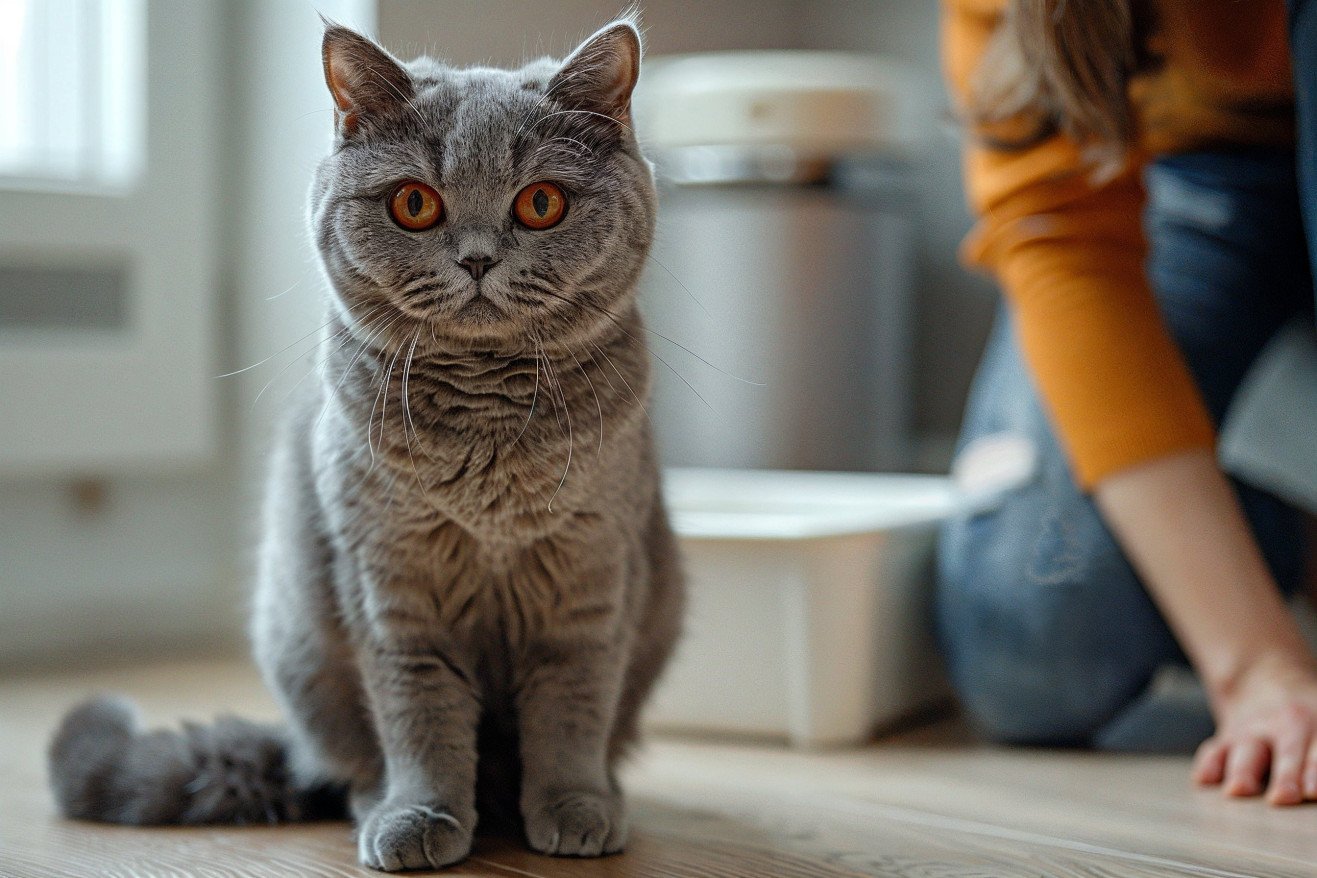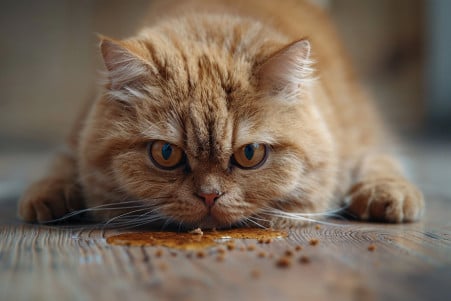Why Is My Cat Pooping Outside the Litter Box? Uncovering the Causes
19 March 2024 • Updated 19 March 2024

One of the most common problems cat owners face is their feline friends pooping outside of their litter boxes. There are many potential causes for cats pooping outside the litter box, including medical issues like arthritis and urinary tract infections (UTIs), stress due to changes in the environment, dislike of the litter or the cleanliness of the box, and behavioral issues like territorial marking.
It’s important to see a vet to rule out any medical concerns.
We will get to the bottom of this mystery by reviewing research from veterinary medicine, animal behaviorism, and feline psychology. We will look at research on medical conditions that can lead to issues with litter box use, explore environmental and stress-related causes, and discuss the role of box construction and litter preference.
Our findings will help you better understand the many causes of this problem and give you the information you need to help your cat.
Why is my cat pooping outside the litter box?
Dealing With the Health Issues That May Be Causing the Behavior
If your cat is peeing or pooping outside of the litter box, there may be an underlying medical issue. Cats can suffer from urinary tract infections (UTIs), arthritis, and gastrointestinal diseases, all of which can cause disruptions in their bathroom habits.
According to PetMD, changes in litter box habits can also be a sign of medical issues such as diabetes or kidney disease, which cause an increase in urination and may cause cats to feel their litter boxes are unclean.
In addition, the Cornell University College of Veterinary Medicine points out that cognitive dysfunction syndrome that comes with old age can cause anxiety, which can lead to changes in a cat’s litter box behavior.
A vet will need to conduct a full exam to diagnose these issues. VCA Hospitals explains that any medical issue that affects a cat’s ability to urinate or defecate can lead to litter box problems. If a medical issue is found, the vet may prescribe medication, recommend changes to your cat’s environment, or suggest changes to your cat’s diet.
It’s important to note that if your cat is peeing or pooping outside of the litter box due to the pain or discomfort caused by a medical issue like arthritis or gastrointestinal problems, they may have come to associate the litter box with that pain or discomfort and may therefore avoid using it.
By treating these medical issues, you may be able to restore litter box use while also improving your cat’s quality of life, which can help you explore other potential causes of the behavior.
How a Cat’s Environment Affects Litter Box Use
A cat’s litter box habits can be heavily influenced by environmental factors. Stress caused by a new home or changes within the home like construction or moving furniture can cause a cat to avoid the litter box. Even changes in the home like new family members or other pets can cause stress that leads to inappropriate elimination, according to The Spruce Pets.
Other factors to consider are the location and cleanliness of the litter box. If a cat feels too exposed when using the litter box, they may not use it due to a lack of privacy. If the litter box is dirty, a cat may not use it because they prefer a clean environment.
Household dynamics also play a role. The presence of other pets or a new baby in the home can stress your cat and lead to marking behavior. The ASPCA recommends that stress can be reduced by placing multiple litter boxes in low-traffic, easy-to-access areas.
You can help encourage proper litter box use by keeping a clean, well-placed litter box in a stress-free environment. By recognizing and adapting to these environmental factors, you can create an environment that your cat feels comfortable and safe in.
Feline Litter Box Mishaps: Investigating Dietary Triggers
A cat’s diet has a major impact on their litter box habits. Dietary sensitivity and fiber content are important for healthy bowel movements.
A study in PMC points out that a cat’s diet determines the composition of the gut microbiome, which has a significant impact on a cat’s health. The food and ingredients in a cat’s diet can change the microbiome, which can, in turn, affect digestion and defecation. An imbalance in the microbiome can cause cats to look for other places to go to the bathroom.
Diet also directly affects nutrient absorption and stool quality. A study in PMC shows that the fiber source Miscanthus grass can affect nutrient absorption, stool quality, and hairball management—all of which can affect litter box use. Meanwhile, Today’s Veterinary Practice explains that the dietary needs of cats are complicated, especially when it comes to hydration and the type of fiber, for cats with idiopathic constipation, which can also lead to litter box avoidance.
Diet-related issues can be hard to pinpoint and may require a change in diet or a change in the ingredients in a cat’s food. If you think your cat’s diet is causing litter box issues, talk to a vet about specific dietary recommendations that can help ensure your cat’s overall nutritional health.
Managing your cat’s diet can help correct inappropriate elimination and maintain digestive health, which can make it easier to move on to the behavioral issues that may be affecting litter box use.
Righting the Ship: Behavioral Solutions for Litter Box Problems
Both anxiety and territorial marking can be behavioral issues that have a big impact on a cat’s litter box behavior. Territorial marking is a common reason cats poop outside the litter box, especially if there are other pets in the home. Anxiety can be brought on by changes in the environment or schedule, which can lead to litter box aversion.
To help with these issues, Alley Cat Allies suggests training and behavioral modification techniques. Alley Cat Allies recommends setting a schedule and using pheromone sprays to help create a calm environment that will reduce stress and encourage the cat to use the litter box. The Spruce Pets also recommends providing toys and playtime to help reduce boredom and stress, which are common causes of behavioral issues.
It’s important to focus on positive reinforcement; rewarding your cat when they use the litter box will help them form positive habits. However, Litter Box Guru warns against using negative reinforcement, as it can make a cat’s aversion and stress worse. Instead, Litter Box Guru suggests being patient and understanding, noting that it can take a cat up to two weeks or longer to adjust to new changes.
If you’re still having trouble after trying these solutions, it may be helpful to work with a cat behaviorist who can provide personalized solutions based on your cat’s specific needs and personality. In any case, the most important thing is to be consistent and patient, working to create a positive association with the litter box without using negative reinforcement.
The Role of Litter Box Design
The design of the litter box is one of the most important factors in shaping a cat’s bathroom behavior. Litter box designs can be open or enclosed, and while a study in the Journal of the American Veterinary Medical Association found that cats don’t have a strong preference for one type of box over the other, individual cats may have their own preferences.
For example, some cats may not use a covered litter box if it isn’t kept very clean.
Litter box aversion can be caused by a cat’s dislike of a certain type of litter or litter box, and an article in PMC by Anna K. Shoveller notes that when changing litter types, it’s important to make the change gradually. The study found that a six-day transition period was sufficient to maintain normal litter box behavior.
The litter box cafeteria concept, which allows cats to choose their preferred litter and litter box, can help prevent litter box aversion. A study on litter box preference by Emma K found that this concept is especially important for cats with a history of elimination disorders.
When choosing a litter box, make sure to take into account the size and cleanliness of the box, offer choices, and make changes gradually to avoid stressing your cat. By tailoring the litter box to your cat’s needs, you can help ensure that they use the litter box consistently and correctly, which will help them stay comfortable and clean.
In Conclusion: What to Know About Your Cat’s Litter Box Habits
There are many reasons why a cat might avoid their litter box, including medical, environmental, dietary, and behavioral causes. Medical issues like UTIs and arthritis can lead to a cat not using the litter box, as can environmental changes and stressors like moving or rearranging furniture.
Dietary issues, especially those related to digestive health, can also impact where a cat goes to the bathroom. Finally, behavioral problems like anxiety and territorial marking can also lead to litter box issues.
It’s important to work with a vet to rule out any medical causes of litter box issues and to treat any medical problems that are found. It’s also important to be patient and observant as you work to figure out what’s causing your cat’s litter box issues. A multi-pronged approach that carefully and compassionately addresses each cause can help you get to the bottom of the issue.
Finally, remember that every cat is an individual with their own likes, dislikes, and needs. By paying attention to these and responding with compassion and understanding, you can help support your cat’s health and happiness and strengthen the bond you share with them.


